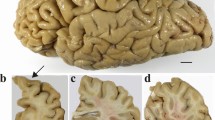Abstract
Studies of histological preparations of the brains of humans and animals with prion diseases showed that neuron vacuolization often starts and develops intensely in the distal segments of dendrites. Two types of neuron body death were noted – cytolysis and pyknosis, the latter usually being associated with vacuolization of dendrites. The involvement of the main types of neuroglia in the pathogenesis of prion diseases was established, which provides grounds for referring to gliosis rather than astrocytosis. Accumulation of phagocytes (microgliocytes, blood macrophages, pericytes) and release of lymphocytes from blood vessels with diffuse infiltration of brain tissues by these cells to form accumulations around degeneratively changed neurons were noted.
Similar content being viewed by others
REFERENCES
T. S. Gulevskaya, “Central nervous system pathology in human prion diseases,” in: Human and Animal Prion Diseases [in Russian], Meditsina, Moscow (1999), pp. 27–61.
V. A. Zuev, I. A. Zavalishin, and V. M. Roikhel', Human and Animal Prion Diseases [in Russian], Meditsina, Moscow (1999).
V. Ya. Karmysheva, Cell Lesions in Virus Infections [in Russian], Meditsina, Moscow (1981).
V. I. Pokrovskii, O. I. Kiselev, and B. L. Cherkasskii, Prions and Prion Diseases [in Russian], RIF “Roza Mira,” St. Petersburg (1998).
A. I. Roitbak, The Glia and Their Role in Nervous Activity [in Russian], Nauka, St. Petersburg (1993).
V. M. Roikhel', “Experimental studies of prion diseases in in vivo systems,” in: Human and Animal Prion Diseases [in Russian], Meditsina, Moscow (1999), pp. 170–184.
S. J. de Armond and J. W. Ironside, “Neuropathology of prion diseases,” in: Prion Biology and Diseases, Cold Spring Harbor Laboratory Press, New York (1999), pp. 585–652.
R. S. Hegde, J. A. Mastrianni, M. R. Scott, et al., “A transmembrane form of prion protein in neurodegenerative disease,” Science, 279, 827–834 (1998).
P. P. Liberski, D. M. Acher, R. Yanagihara, et al., “Serial ultrastructural studies of scrapie in hamsters,” J. Comp. Pathol., 101, 429–442 (1989).
Prion Biology and Diseases, S. B. Prusiner (ed.), Cold Spring Harbor Laboratory Press (1999).
S. B. Prusiner, P. Peters, K. Kaneko, et al., Cell Biology of Prion, Cold Spring Harbor Laboratory Press (1999), pp. 349–391.
Author information
Authors and Affiliations
Rights and permissions
About this article
Cite this article
Karmysheva, V.Y., Pogodina, V.V. & Roikhel', V.M. Cytopathological Changes in Human and Animals Brains in Prion Diseases. Neurosci Behav Physiol 34, 509–513 (2004). https://doi.org/10.1023/B:NEAB.0000022639.59501.30
Issue Date:
DOI: https://doi.org/10.1023/B:NEAB.0000022639.59501.30




